How to Make Pumpkin Vinegar
Pumpkin vinegar is made via a two-part fermentation process. First, yeast consume sugars within fruits to produce alcohol, known as alcoholic fermentation.
Second, acetic acid bacteria consume the alcohol from step one and convert it into acetic acid. Once all the alcohol is metabolized by bacteria and converted into acetic acid, you have vinegar.
To make pumpkin vinegar at home, you first make something similar to wild pumpkin wine, which then turns to pumpkin vinegar! I first roasted the pumpkin for this recipe to release more sugars and develop the flavor. This recipe is similar to many other types of fruit scrap vinegar.
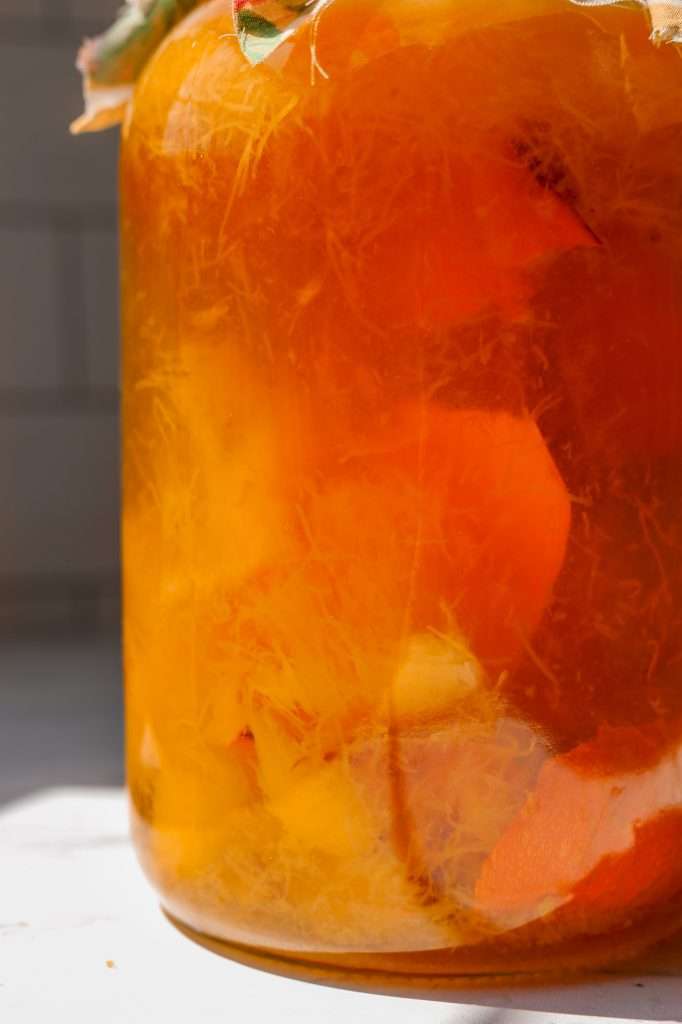
How to Make Vinegar With Roasted Pumpkin
It is so easy to make vinegar with roasted pumpkin. You only need a few ingredients: fresh pumpkin, sugar, raw vinegar (as a starter culture), and water. It’s important to leave out any oil. You should dry roast the pumpkin with NO OIL. The skin of the pumpkin will naturally release some oil when you roast it, and that is fine.
If you use oil to roast the pumpkin, it will cause significant issues and mess up the fermentation process. The microbes that turn alcohol into acetic acid require oxygen. If oil floats on the surface of the vinegar, it will disrupt these microbes.
For a starter, you need some raw apple cider vinegar with the mother as a starter. It is 100% necessary in this recipe since the pumpkin is roasted. If you do not use some raw vinegar from the store or a previous batch as a starter, things can quickly go wrong.
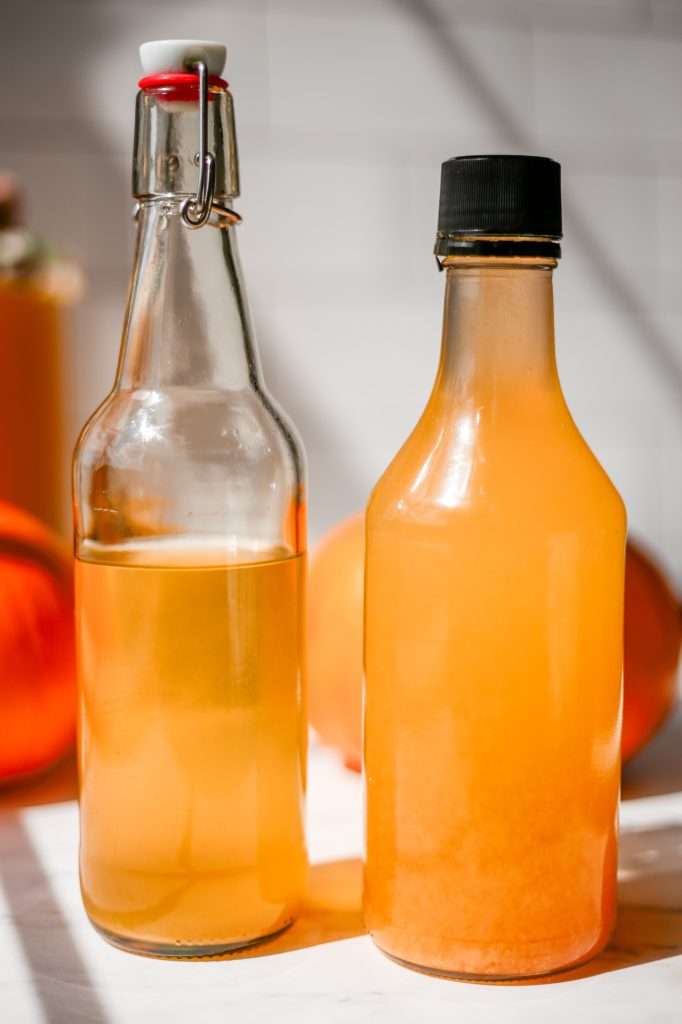
The Best Pumpkin Varieties to Use
- New England Pie Pumpkin
- any kind of Sugar Pumpkins
- Sugar Baby
- Baby Pam
- Baby Bear
- Sugar Bush

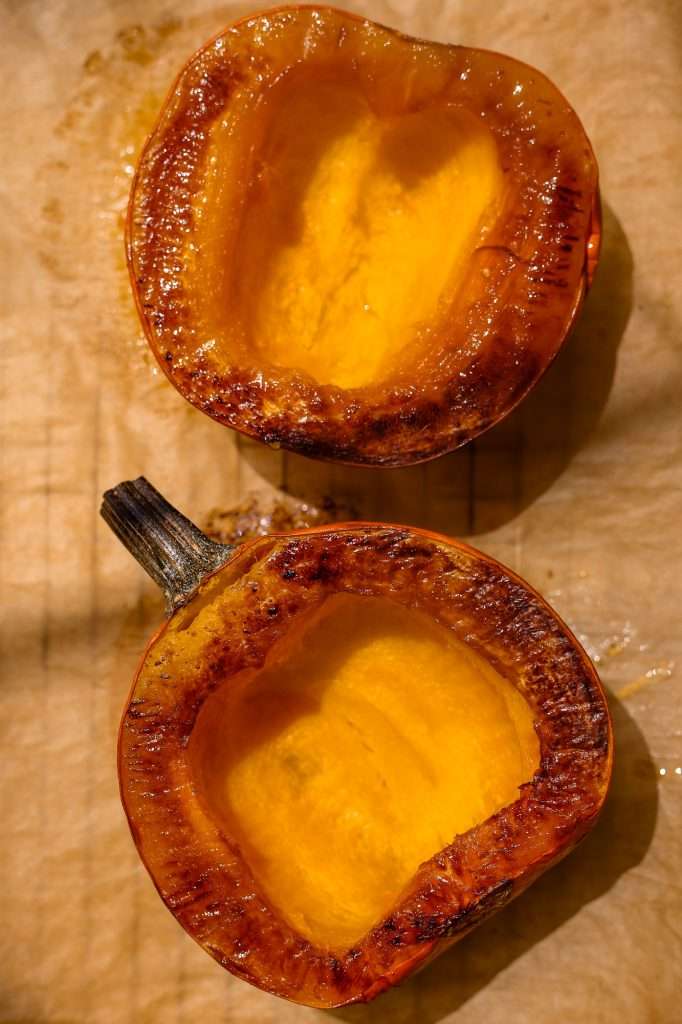
What is a Vinegar Mother?
Vinegar “with the mother” is another name for raw vinegar containing all the microbes from the brewing process. So, think of the mother as microbial cultures. Vinegar mothers form cloudy floating pieces within the vinegar and a SCOBY on the surface.
A vinegar mother SCOBY looks similar to a kombucha SCOBY but is often lighter with varying textures. Vinegar mothers in homemade vinegar are always unique. No two will look exactly the same because the wild microbes from fruit scraps will be slightly different across batches. If it’s not chalky or fuzzy, it’s probably a perfectly ordinary mother.
You can use the vinegar mother SCOBY from your first batch of vinegar to culture the next batch of vinegar.


Equipment for Pumpkin Vinegar Fermentation
I suggest a gallon glass jar and a cloth cover with a rubber band for this recipe.
You must use a cloth lid when making vinegar because acetic acid bacteria require oxygen to convert alcohol into acetic acid. I usually make cloth lids for fermentation by cutting up old t-shirts.
Here is all the equipment you need:
- 1 gallon glass jar
- a tight-weave cloth lid and a rubber band
- a kitchen scale
- large spoon (for stirring daily)
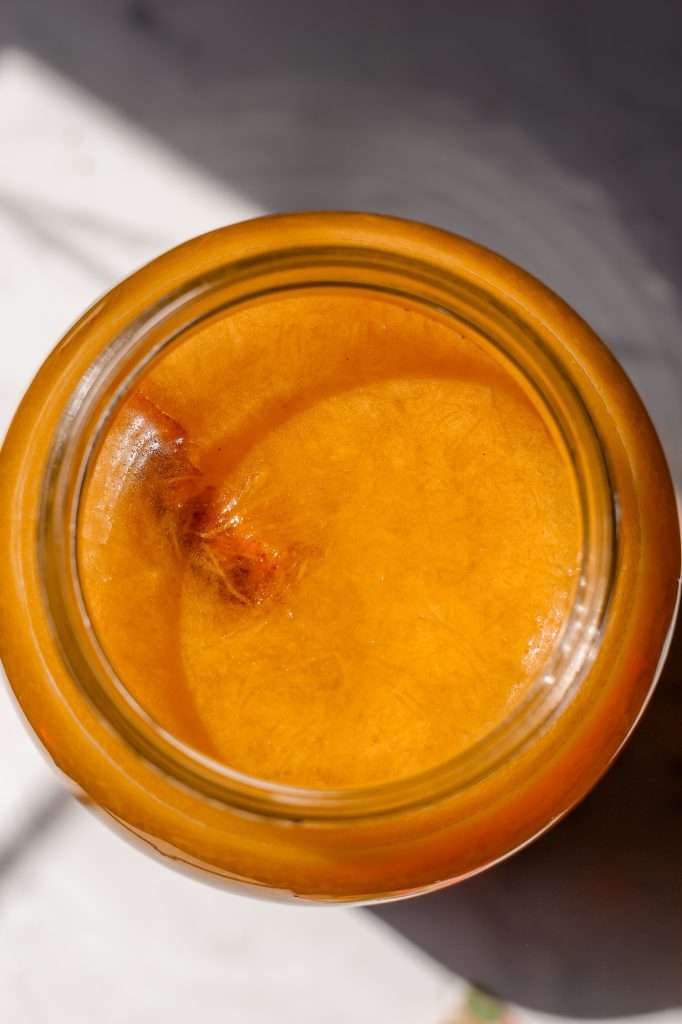
What Do You Use Pumpkin Vinegar For?
I use my homemade pumpkin vinegar in any recipe where I would use store-bought apple cider vinegar.
Pumpkin vinegar may or may not be adequate for pickling and canning pickles. It depends on how ripe the pumpkin is and the type you are using. Pie pumpkins, for instance, have more sugar. To make a strongly acidic vinegar, use more sugar and a small pie pumpkin. For very strong vinegar, you can also add in some sulfite-free wine, tequila, or vodka in place of some of the water.
You can also test the pH with a pH strip to see if it is good for pickling/canning. Vinegar that is safe for pickling recipes should have approximately 2.4 pH (about 5% acidity).
Here are my favorite ways to use homemade vinegar:
- for homemade salad dressing
- in heirloom culturing recipes like this fermented green tomato recipe
- I love to drizzle it over honeydew melon with raw honey and a pinch of salt.
- In mineral-rich hydrating drinks (I like to mix a tablespoon of fruit vinegar into a quart of water with a splash of coconut water, orange juice, and a pinch of sea salt for a homemade hydrating “Gatorade”)
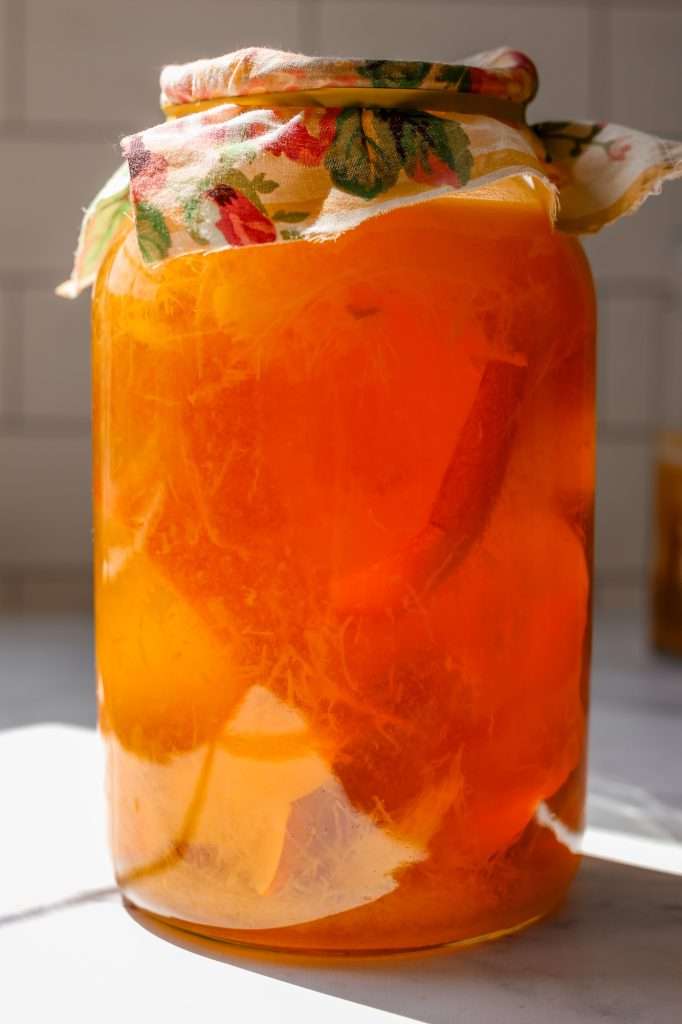
Homemade Roasted Pumpkin Vinegar
The keys to remember when making pumpkin vinegar or any fruit vinegar at home:
- Stir the vinegar once daily. Remove the cloth lid, give it a good stir, replace the lid, and repeat daily until you strain the vinegar.
- You must use a breathable cloth lid. The microbes involved in vinegar production require oxygen to convert alcohol to acetic acid.
- Use a clean glass container. It is best to use glass when fermenting acidic vinegar. Clean your equipment well before getting started.
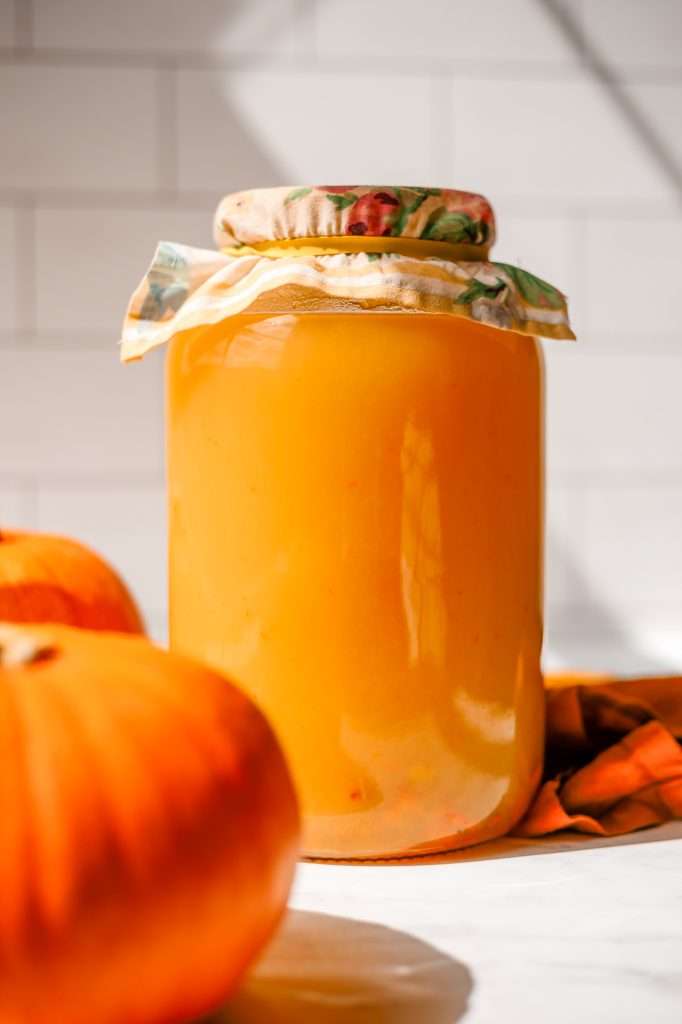

Roasted Pumpkin Vinegar From Scratch
My seasonal roasted pumpkin vinegar recipe requires only four ingredients: roasted pumpkin, sugar, raw vinegar for a starter culture, and water. This is the perfect recipe to use up some extra pumpkins in the fall.
- Prep: 30 minutes
- Cook: 30 minutes
- Total Time: 1513 hours
Ingredients
- 6 cups chopped lightly roasted pumpkin
- 255 grams of organic cane sugar
- Water
- 3 tablespoons raw vinegar with the mother*
- 1-gallon glass jar
- cloth covering
- rubber band
Instructions
- Please read the recipe notes.
- Lightly roast the pumpkin: cut the pumpkin in half, place on a parchment paper lined pan, and roast at 425° F for 25 minutes. Do NOT use oil; dry roast the pumpkin.
- Chop the pumpkin into chunks.
- Add the sugar and pumpkin (with the skin) to a 1-gallon glass jar.
- Add water to the jar until full.
- Add in a few tablespoons of raw vinegar with the mother. This helps establish a good microbial community (see notes below)
- Stir the mixture until all the sugar is dissolved.
- Place a tight-weave cloth lid on the jar and secure with a rubber band.
- Stir the mixture once or twice a day and allow to ferment at room temperature for three weeks. Don’t forget to stir it. I like to just do it first thing in the morning each day. You can expect the pumpkin to disintegrate and fall apart the more you stir.
- You should notice the mixture bubble within one week. It will also become very cloudy.
- After three weeks of fermentation, strain out all the pumpkin pieces, replace the cloth lid and allow the mixture to ferment for 6 more weeks. Once it is strained you do not need to stir it.
- You will notice a vinegar mother form on the surface (it looks like a kombucha SCOBY but is very light in color). You can keep this to start your next batch of vinegar.
- After fermentation, bottle the vinegar and seal it with a solid lid. Store at room temperature in your pantry.
Notes
- Vinegar works best with a starter culture. Especially since the fruit is roasted in this recipe. While it is possible to make vinegar without it (when using raw fruit), adding a vinegar mother or raw apple cider vinegar with the mother to the mixture ensures success. If you have a kombucha SCOBY or raw kombucha, you can sub for that with good results.
- For very strong vinegar, you can also add in some sulfite-free wine, tequila, or vodka in place of some of the water.




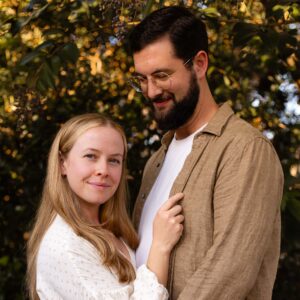

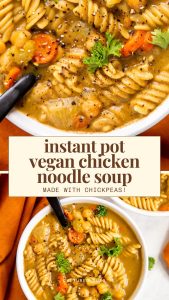


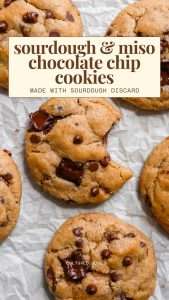










I just harvested my pumpkins and this recipe popped up so of course I wanted to make it. The biggest concern I have so far is that I don’t want to use gallon jars for any vinegar recipe and wonder why a whole gallon is used for every recipe? I would never consume that much vinegar in a year so I would rather go smaller. I only want to use 32 ounce jars at this point. So I have been cutting the recipes in 1/4. Does that work? I would like to eventually get some gallon jars but I am hesitant to spend a lot of money on new jars, not knowing if I even like the vinegar or can I keep up with process to see it through. I have other jars that need daily attention so each new recipe is a new responsibility to keep track of. Also, my tomato vinegar has white residue when I open it daily. Assuming it’s fine but what is it? None of the other vinegars I am making has white stuff on them. Another question, what are some cues that it is turning from alcohol to vinegar? Smell? Cloudy to clear? Is is that the 3 week point? They all smell good so far. I have 2 on day 10 and this one is on day 2. Is it Safe to consume before it turns?
I like to make vinegar in big batches. I use vinegar every day pretty much. In the winter I use it to make my fire cider and oxymel, it’s also great in braises and broths. I also give away a lot to friends and family and get a lot of joy out of sharing it. If you don’t like having that much vinegar, then feel free to divide by 4 and make a quart. The tomato vinegar recipe is one quart if you want to go by those amounts. If the residue is floating on the surface that could be yeast, which is normal, keep stirring it. If its a sediment on the tomatoes within the liquid, that is also just microbes and normal. The cues that it is turning from alcohol to vinegar is the smell. It will first smell sweet floral and alcoholic. then sometimes you’ll sense some acetone smells mid way through. Last it will smell like vinegar. No, you should wait until it is done to use it, follow the time directions in the recipe.
I made this and it just finished after 9 weeks. It’s subtle tasting and very thick. It’s good but I’m not quite sure what I will use it for and probably will not make it again. I know I can make salad dressings and such but it’s such an interesting taste and much more novel than the standard ACV.
I suggest using it in braising recipes and marinades! It’s good in savory recipes.
I made your fruit vinegar recipe with persimmons. Once it’s finished what do you do with the SCOBY?
I store the scoby (vinegar mother) in a small jar of vinegar at room temperature, until I’m ready to use it in the next batch.
Thankyou for this. I’ll try this. One question, can I use my native bee honey instead of sugar. I recently made apple scrap vinegar so can use its scoby and, it occurs to me, I could make this vinegar totally from things on my property. One more question. I intend to reduce some of my apple vinegar into a glaze. Do you think this would work with pumpkin toi
yes! honey works wonderfully for brewing vinegar. and you can slow cook and reduce the vinegars.